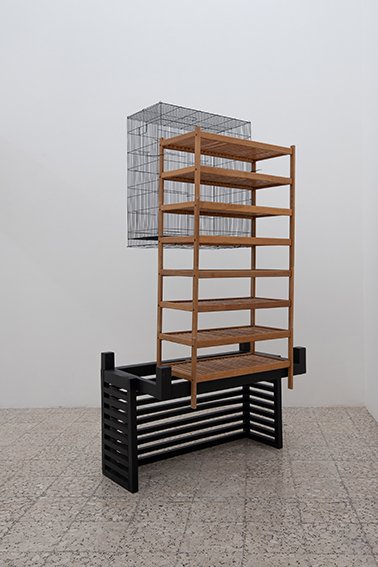Exploring the Artistic Mind of Savvas Christodoulides

A journey into the creative process and philosophical insights of a renowned Cypriot artist
Savvas Christodoulides discusses his artistic process, the emotional and intellectual interplay in his work, and the dualities that shape his unique artistic vision.
Savvas Christodoulides, a distinguished artist and academic, has carved a unique niche in the contemporary art world with his profound and evocative works. Born in Pafos, Cyprus, and now residing in Nicosia, Christodoulides has an impressive academic background, having studied at the National School of Fine Arts of Toulouse and earning a PhD from the University of Provence. His artistic journey has seen him participate in prestigious exhibitions such as the Venice Biennial, the Athens Biennial, and the Biennial of Sao Paulo. His solo exhibitions have graced renowned galleries across Europe, showcasing his ability to weave complex narratives through found objects and materials. His works are celebrated for their intellectual depth and emotional resonance, earning a place in esteemed collections like the Tate Gallery in London and the Guggenheim Museum in New York.
Christodoulides’s contributions to art extend beyond his creations; he is a prolific writer and curator, having published numerous papers and curated significant exhibitions. His role as a professor at Frederick University in Nicosia further underscores his commitment to nurturing the next generation of artists. In this exclusive interview with Mosaic Digest, we delve into the mind of Savvas Christodoulides, exploring the intricate processes and philosophies that underpin his art. His reflections on the interplay between sensory perception and aesthetic transformation offer a glimpse into the heart and mind of an artist who continues to challenge and inspire.
Can you describe your process for selecting the found objects that you use in your artwork, and what personal significance they hold for you?
Each work presupposes intellectual groundwork that is often as intensive as the physical process of producing the work. I think this mental effort is recorded and reflected in my work in various ways. One is the discipline and concentration that I bring to the process of selecting the objects themselves, which is largely a function of the surprise and emotion they provoke.
The nature of the materials and especially the aura of the objects also play a decisive role in the creative process. They dictate how the objects are assembled: that is, the osmosis and coherence of the materials in internal dialogues, from which a new entity with its own autonomy emerges. The whole process is highly autobiographical, a kind of personal adventure of interaction with fragments or shards of collective memory.
“Each work presupposes intellectual groundwork that is often as intensive as the physical process of producing the work.” – Christodoulides
In what ways do you believe the materials you choose influence the emotional resonance of your work, particularly in relation to the concepts of the heart thinking and the mind feeling?
I think the best way to express my relationship to both art and life is through the motto: “Think with the senses – feel with the mind.” For me, the dyad of emotion and thought are essentially two sides of the same coin. Seen in this light, the materials I select and work with function as a means of transposition from an initial sensory perception to its aesthetic transformation. The work thus carries a hybrid DNA of heart and mind, which can be seen throughout the creative process, from the moment I encounter and select the primary structural materials to the articulation of the title that completes the work.
“Think with the senses – feel with the mind.” – Christodoulides

How do you view the relationship between the visual elements in your compositions and the accompanying textual narratives? What role does language play in your artistic expression?
The purely verbal aspect of the compositions is the title that I select. Sometimes it functions as a narrative caption, other times as a self-contained textual reference, and still other times as a form of metaphorical language that signals what we call philosophical irony. In each case, I believe titles can encapsulate the meaning inherent in the core of the work, provide interpretive directions that broaden the field of perception, or even serve as subversive devices. The most successful titles are those that manage to instantly convey a sense of the entire visual experience.
Your works often suggest a blend of realistic and transcendental themes. How do you navigate these dualities in your creative process, and what do they mean to you personally?
The transition from what we understand as the “real” to what we assume to be its transcendence has always been, and continues to be the ultimate aspiration of every form of art, as we can clearly see in the great upheavals and periods of stagnation in the history of art.
Several critics have highlighted this in my work and pointed out the contrapuntal dualities in conceptual pairs. Characteristic examples of such contrastive pairs include the trivial the precious, the solid and the permeable, and the directional indicators between levels and gradients. Through their opposition a concept of reconciliation emerges, which speaks to essential truths about art and life.

PRAISE
Savvas Christodoulides: Recent Works
I first met Savvas Christodoulides in 1984, as he was studying art in Toulouse, France, while I was figuring out my path as a writer, between poetry and philosophy. We have since kept contact, despite living at long distances and in diverse continents, despite the unceasing waves of life.
Savvas Christodoulides is one of the most brilliant artists I have had the privilege of following. I admire his aristocratic indifference vis-à-vis the urgencies of trends and fashion, and I have witnessed, time and again, the unwavering capacity for anticipation that his art bears: Christodoulides has already been there, done that, before everyone else, and certainly before the crowds.
His art, in whatever medium he accomplishes it, features an ancient virtue called sprezzatura. Attributed in old art treatises to painters embodying ‘difficult easiness’ in their work, notably those who were able to show facility where there is extreme difficulty, sprezzatura is a concept that Savvas Christodoulides masterfully exemplifies in new formal territories.
The word masterfully might seem, however, contrary to sprezzatura, precisely because the essence of ‘difficult easiness’ is opposed to the display of virtuosity. Sprezzatura operates by spontaneously shrouding virtuosity so the works that result from it do not suffer from the often-tedious laboriousness found in the ‘virtuoso’. If Christodoulides arts lives, and I certainly believe that it breathes with amplitude, wit, elegance, wise economy of medium, and unexpected poetry, it is because there is no virtuosity -but rather spontaneous ingenuity- involved in the masterful genius of its assemblages, its material core.
Savvas Christodoulides has built his oeuvre on the legacy of the modern objet trouvé. His sculptures are three-dimensional ‘collages’, resulting from a logic of ‘montage’ where unlikely connected furniture-elements define a poetics of bricolage, asimages connected despite their diversity, featuring an aesthetics of de-functioning (desoeuvrement
), a weaving of what normally cannot be woven. But there is also a resonance of classicism in his oeuvre, for the best description of the agency that his sculptural assemblages convey could be that old, winckelmannian expression: a ‘noble simplicity’, a ‘quiet grandeur’ -metamorphosed into a radical contemporary language.
The profound poetic effect of Christodoulides’ objects therefore lies on the vivid colliding of cultures, ancient and modern, forgotten and current that someone born in Paphos -the very birthplace of Venus- might embody. It is fitting to recall the term defining the ineffable quality of masterworks since Plinius’ Natural History: ‘charis’ or ‘grace’, also named ‘venusté’. In Christodoulides’ work there is unexpected ‘venusté’, the unpredictable seduction of objects intentionally divested from their function, expanding our perception through an endless array of connotations. Of all these new sculptures there is one -ironically titled Titan– that summarizes the common thread of the show -and maybe the ageless endeavor of artists-: to carry the world on the shoulders, like an Atlas, to stack objects over objects, things over things, bodies over bodies in order to listen, from the empty cage of the present, a long-ago song of birds, a language no-one fully grasps, revealing in lightness the resounding beauty that comes from the inexhaustible survival of Babel.
Luis Pérez-Oramas
Art Historian, Curator
New York. April 2024












